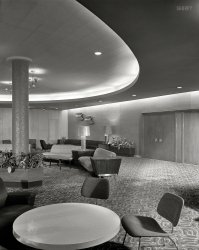
MAY CONTAIN NUTS

Search Shorpy
SHORPY ART

Framed or unframed, desk size to sofa size, printed by us in Arizona and Alabama since 2007. Explore now.
Join and Share
Ad-Free Shorpy
Shorpy is funded by you. Patreon contributors get an ad-free experience.
Learn more.

Recent comments
- Robie House Roof(s)
- There is an interesting novel set here.
- I Was In Berlin
- Pronunciation
- Shell of a Shell
- Never been there but
- BUR-lin
- Hand-made smokes
- Birthplace of Tupperware, or at least its inventor
- Pulp
- Remarkably unchanged in 84 years
- The church is still there ...
- Talk about a smoke show
- Electric Hansom Cab
- I wondered the same thing.
- The location in 2009
- Pill Pusher
- Roll your own
- Rugged and real!
- Civil War history
- Early EV?
- A Charles Purcell - Mama Cass Connection
- Uncle SAAM
- Obfuscation
- One Chocolate Soldier rode away
- Victor Marquis de la Roche
- The Little House Across Way ...
- Vanderbilt Gates
- Vanderbilt Mansion
- You can still see that gate
Member Photos
The Shorpy
Printporium
Printporium
Search Shorpy
Search results -- 30 results per page
- Perilous Crossing: 1900
- ... Roads, Virginia, circa 1900. "Going to the landing stage. Hotel Chamberlin in background." Although the harbor might not be mined, the ... Posted by Dave - 04/02/2013 - 7:52am -
![Perilous Crossing: 1900 Hampton Roads, Virginia, circa 1900. "Going to the landing stage. Hotel Chamberlin in background." Although the harbor might not be mined, the street is. 8x10 inch glass negative, Detroit Photographic Company. View full size.
Great ExpectationsI fully expect Bustor Keaton to show up and start something any second.
[And if not him, Buster Keaton, although he'd be only five years old. - tterrace]
And whatever makes you think Buster at five couldn't raise hell? The kid learned
young!
Now a Senior Living CommunityThe Chamberlin is on Ft. Monroe...
[The current Chamberlin is a different structure on the same site. The one in our photo burned to the ground in 1920. - tterrace]
Fancy!They really knew how to attire crossing guards in those days.
Furry Accessory?I'm curious about the woman in the center right of the photo, wearing the light-colored suit. On her left arm she has what appears to be a dark fur muff, but it also has two long strips coming from it that look like more fur with a silk lining. I'd say it was a scarf, but she's already wearing a different type of fur piece around her neck. What's the long trailing thing?
Dark Fur MuffAmeliaEve, I'd guess the item that the older woman is carrying is a satin-lined velvet pelerine, probably not designed to be worn with the outfit she has on.
It's earlier than you thinkBeing a fashion history nerd, I would date this photo closer to 1895, based on the large "leg of mutton" sleeves on the ladies' jackets. The fur piece with the hanging tabs the the older woman is carrying is a capelet; the semi-circular part would rest on her shoulders, over the tops of her large sleeves, and the tabs would hang down in front on either side of the center front of her jacket, to counter balance the weight of the cape, and keep it from slipping down her back.
[Did clothing styles go out of fashion that quickly back then? - tterrace]
Yes, fashion changed that fast.Remaking clothing to reflect the latest styles was commonplace, and things like sleeves were frequently re-cut. I'm going to agree with the fashion nerd on the dating of this pic.
(The Gallery, DPC, Horses)](https://www.shorpy.com/files/images/SHORPY_4a15014a.thumbnail.jpg)
- Chicago Beach: 1900
- The Windy City circa 1900. "Chicago Beach Hotel, Hyde Park Boulevard." On the Lake Michigan Riviera. 8x10 inch dry plate ... Posted by Dave - 05/25/2017 - 8:01pm -
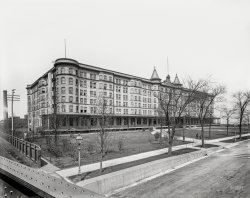
- Every Dog Has His Doubts: 1940
- ... of a Basque handball court stands behind the Tourist Home Hotel -- formerly a rooming house catering to Basques.
The mountain west ... Posted by Dave - 05/27/2019 - 1:26pm -
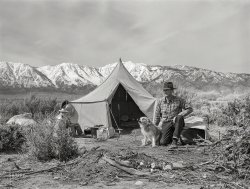
- High Street: 1908
- ... was constructed from Vermont marble and was originally a hotel. By 1900 it was converted to Child's Shoes which was one of the largest ... Posted by Dave - 08/09/2012 - 6:18pm -
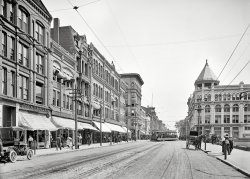
- The Stag: 1938
- ... form of private room. I was once in a disused flophouse "Hotel"- rooms barely big enough to contain a bed, many windowless.
Any ... Posted by Dave - 08/02/2017 - 9:25am -
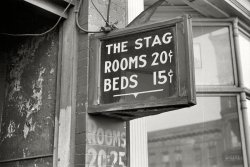
- Bob & Paul: 1910
- ... tower and flagpole just right of center belong to the Ryan Hotel, at 6th and Robert, demolished 1962.
+98 Below is the same view ... Posted by Dave - 08/23/2017 - 9:46am -
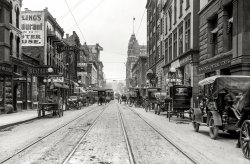
- Trail Ride: 1912
- ... the remnants of the Mount Lowe funicular railway head and hotel ruins from Lowe's Alpine Tavern.
I find Dave's grammar comments ... Posted by Dave - 01/06/2019 - 11:32am -
![Trail Ride: 1912 California (?) circa 1912. "On the trail." A Supposedly Fun Thing I'll Never Do Again: The Prequel. 8x10 inch dry plate glass negative. View full size.
Sidesaddle switch?The women, and the young man in front, are riding astride, but the two men to the back are sidesaddle -- is there some purpose to this? Or maybe they were just fooling around for the photo.
Grammer Police Shorpy DivisionI have to wonder why an otherwise fun and interesting web site posting found and borrowed photos would feel it to be great fun attacking folks who innocently (but grammatically and incorrectly) post their thoughts. I think a more mature web site owner would just let it pass. Been following your site for over 10 years and have had to shake my head many times over your hectoring various posters who don't meet your standards. Kind of a sad way to run things.
[You spelled "grammar" wrong. - Dave]
Fun for a whileUntil one of those burro's see's a rattlesnake. Then it's off to Kentucky Derby. Pronto. Mighty steep dropoff on the left.
[Why the apostrophes in "burro's" and "see's"? - Dave]
Not Burros (not burro's either)Those are mules and they'll stomp the stuffing out of a rattlesnake.
I remember that viewIt was about seven decades later, and yes, that landscape does look like California, which is where I remember it. I wasn't riding the mules. I had to get off the trail for them, and most of them were carrying cargo.
My Burro's NameIf I ever ride a burro on one of those narrow trails down the Grand Canyon my burro's name would be "Stumblefoot"
I guess, DaveJust to far gone from seventh grade English class.
[Too. Burros. Sees! - Dave]
I think Dave was a nun in a previous life.Definitely a case where the corrections are usually more noxious than the gaffes.
Awesome site though, weird quirks and all.
Near AltadenaI'm willing to bet this is the road to Mount Lowe Trail Camp, which I've hiked many times. I base my opinion on the general range skyline. Here's a modern panorama:
https://goo.gl/maps/jZG8W3VNrqE2
If you zoom around, you can see the remnants of the Mount Lowe funicular railway head and hotel ruins from Lowe's Alpine Tavern.
I find Dave's grammar comments amusing.
(The Gallery, DPC, Horses)](https://www.shorpy.com/files/images/SHORPY-4a24557a.thumbnail.jpg)
- Corpus Christi: 1943
- ... A renovated version of the logo "flies" atop the Magnolia Hotel in Dallas. A history can be found here: ... Posted by Dave - 12/05/2013 - 10:29am -
![Corpus Christi: 1943 June 1943. "Corpus Christi, Texas." The Ascension. Medium format negative by John Vachon for the Office of War Information. View full size.
There's a Red Flying Horse By the Road SideI saw this picture and the line above from the Kevin Welch song "Early Summer Rain" immediately popped into my head. He also has a nice story about memories of the red flying horse on his Blawg. I also have childhood memories of the red flying Pegasus above Mobil stations but they are much fuzzier.
Still ascending over DallasThe pegasus was originally the logo of the Dallas-based Magnolia Oil Company, which became part of Mobil Oil through a merger in 1959.
A renovated version of the logo "flies" atop the Magnolia Hotel in Dallas. A history can be found here: http://www.magnoliahotels.com/pdf/pegasus-article-121211.pdf
Escape from the mundaneThis is a classic photographic composition in my opinion, a study in stark contrasts, which includes a narrative: Earth and sky, dark and light, the simplicity of life, and the dream of winged escape from the mundane.
I'd recognize that shadow anywhere.Having pumped Ethyl as a wee lad, I wore the Mobil Pegasus on my chest while doing so.
Dave's Mobil in Blue Springs, Missouri.
Somebody knows, but I don'tWhat's the hoopy thing?
[A stand to hold a round sign, like those here and here. -tterrace]
Two thingsTwo things about this photo strike a chord with me. In 1969 (when I was nine) a had surgery at Parkland Hospital in Dallas. There was a Pegasus, perhaps the one in kirkbrewer's post, outside my window. I loved looking at it, especially at night. We moved to Corpus when I as a teenager and I lived there until I joined the Navy in 1982 (I haven't been back since, except for short visits). There's not a lot in this photo from which I can get my bearings, but it sure is as flat and nondescript as I remember.
(The Gallery, Gas Stations, Horses, John Vachon)](https://www.shorpy.com/files/images/SHORPY_8d31645a.thumbnail.jpg)
- Colonial Cleveland: 1900
- Circa 1900. "Colonial Hotel, Cleveland." Home to the Colonial Arcade . 8x10 inch dry plate glass ... Posted by Dave - 02/17/2015 - 12:23pm -
![Colonial Cleveland: 1900 Circa 1900. "Colonial Hotel, Cleveland." Home to the Colonial Arcade. 8x10 inch dry plate glass negative, Detroit Publishing Company. View full size.
Handy & ConvenientFrom an ad for the Hoyt, Kent & Sefton Company: "Our big restaurant. - It is not only the shopper who finds our restaurant on the fifth floor so handy and convenient, but the business men of the neighborhood have quickly recognized its many advantages, its tempting cooking, its varied menu, its prompt service and moderate prices."
PictureI'm still amazed how sharp these pictures here are.
No diapersAm I the only one uncomfortable with the placement of foodstuffs so close to the curb where a horse is tethered?
Cleveland & Eastern RailwayAt the far right of the photo can be seen the depot of the Cleveland and Eastern Ry. I live near one of the destinations mentioned on the sign: Chardon, Burton, Middlefield and Punderson Lake. The primary source of revenue from this line was milk and produce carried into Cleveland from the farms of Geauga County, Ohio, and, during the summer months, picnickers visiting the rural countryside picking berries and buying maple syrup. The line went bankrupt in 1904 and was finally abandoned in March of 1925. Parts of the right-of-way can still be seen including a steel trestle in Gates Mills, Ohio.
What's going on here?Is that a feminist with a protest sign just looking to kick the bejabbers out of anyone who disagreed? Or just a woman (i think) waiting for the trolley? This is what i love about Shorpy; all those intriguing background details. I'm going to spend way too much time today thinking about this.
[Looks like a Woman's Christian Temperance Union picket. -tterrace]
[Also seen five years ago here. -Dave]
Probably an early Salvation Army bellringerCompare the clothing and sign to this SA woman soliciting funds to provide Christmas dinners to the poor in New York circa 1900.
(The Gallery, Cleveland, DPC)](https://www.shorpy.com/files/images/SHORPY-4a08595a.thumbnail.jpg)
- New Capital: 1910
- Little Rock, Arkansas, circa 1910. "New Capital Hotel, Markham Street." A century later the building looks much the same, ... Company. View full size.
The view While the hotel now directly faces the much larger Marriott (née Excelsior) and ... Posted by Dave - 11/20/2015 - 11:08am -
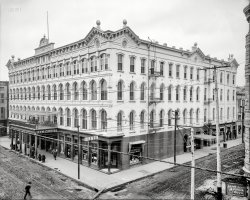
- The Dennis: 1908
- The Atlantic City Boardwalk circa 1908. "Hotel Dennis." And the Marlborough-Blenheim at right, along with a number of ... Looks like the Monopoly game tycoon wondering what hotel to buy next.
Curtain Call The folks facing the camera look like ... Posted by Dave - 09/21/2012 - 11:04am -
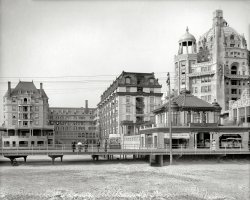
- Coney Island Mardi Gras: 1908
- ... Moxie! Great stuff. There was apparently a "Mardi Gras Hotel" in Coney Island. Who knew?
Sale of confetti stopped!!! Looks ... Posted by Dave - 08/19/2012 - 4:49pm -
![Coney Island Mardi Gras: 1908 "Coney Island Mardi Gras 1908." Some interesting signs in this one. 8x10 glass negative, George Grantham Bain Collection. View full size.
Chop Suey and German BeerAnd Moxie! Great stuff. There was apparently a "Mardi Gras Hotel" in Coney Island. Who knew?
Sale of confetti stopped!!!Looks like the celebration two years earlier got a little out of hand.
[The curse of rowdyism! Not to mention its handmaidens-in-horseplay, boisterousness and hooliganism. Click the clippings to enlarge. - Dave]
1906:
1909:
1911:
An AffrontThe word "affronted" in the bottom of the newpaper articles (thank you Vic)... Just love that word, don't know if I've ever used it in a sentence but am certainly intrigued by the possibility. Plus the idea of "affronting" a woman has got my imagination going overtime.
Sigh, the perils of way too much time on one's hands.
(The Gallery, Cars, Trucks, Buses, Coney Island, G.G. Bain)](https://www.shorpy.com/files/images/01505u.thumbnail.jpg)
- Somewhere in San Diego
- ... couple of sports cars for starters. I want to stay at the Hotel San Diego and check out all the neon. Lastly, let's invite that sailor ... replaced by the Hall Of Justice in 1997 or so.
The Hotel San Diego coffee shop was a preferred break destination for personnel ... Posted by brianvnt90 - 10/13/2011 - 7:26am -
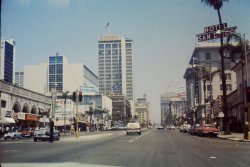
- Cockaday and Banning: 1924
- ... sold
1927: On the advisory board for WGL based at the Hotel Majestic (the station lasted less than two years).
1931: In March ... Posted by Dave - 09/13/2012 - 4:20pm -
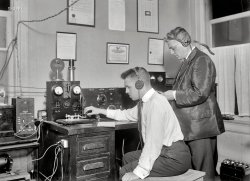
- Washington Masonic Memorial: 1923
- ... officer to be killed in the war when he was shot by a hotel proprietor after taking down the Confederate national flag from the hotel roof. The photo looks east toward Alexandria and the Potomac river. King ... Posted by Dave - 02/23/2013 - 3:09am -
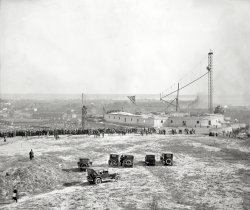
- Seminole Club: 1910
- ... a number of shots from 1910; like the ones at the Gayoso Hotel in Memphis. What is it?
Transit Exploring the ever-astonishing ... Posted by Dave - 08/15/2012 - 2:38pm -
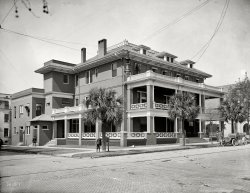
- The Willard: 1904
- Washington, D.C., circa 1904. "Willard Hotel, Pennsylvania Avenue and 14th Street." 8x10 inch glass negative, Detroit ... J. Gardiner, whose later (mis)management of the Grand Hotel bar at 15th & Penn. was the subject of important legal proceedings. ... Posted by Dave - 05/11/2017 - 12:32pm -
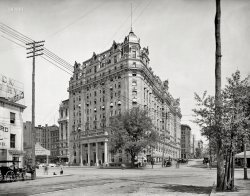
- The Sugar Factory: 1915
- ... cannot see the Carqueniz Straits behind, but where the old hotel is now spans the Carqueniz Bridge, and I believe Amtrak goes right past. ... Posted by Dave - 12/11/2013 - 10:42am -
![The Sugar Factory: 1915 Crockett, Calif., circa 1915. "South view of refinery and entrance to Loring Avenue." Plant of the California & Hawaii Sugar Refining Co. View full size.
Confused [normal]I gather that Crockett is in California so how does Hawaii fit in except as a source for the raw materials used.
[See this. -tterrace]
The references to the sugar cane fields is what confused me . Thanks for the help!! Need all I can get at times.
Pure cane sugar from HawaiiThat old building on the left - apparently the main factory - is still there. You cannot see the Carqueniz Straits behind, but where the old hotel is now spans the Carqueniz Bridge, and I believe Amtrak goes right past. It's a tiny town, in some places definitely showing its age, but it's still adorable. The factory is, I believe, still in use as well.
Crockett todayAs close as I can make it...
Moon over sugarcaneThat was back when most of the flat land on the Hawaiian islands was in sugarcane! I doubt there is any left. When I got there, as a teen, in 1970, there were still lots of cane fields, on Oahu, where we lived. We teenagers had all kinds of good places to "park" after football games and dances. By the time I left, 3.5 years later, the cane fields, and most of the pineapple fields, were covered with condos. I've wondered where the teenagers go to "spoon", now!
The Sugar FactoryWe lived in Crockett about 35 years ago. It hasn't changed too much since then, but the area around is much more built up.
The factory sirens would sound off at about 7:30 a.m., noon, and 5:30 p.m. and they were very loud. The volunteer fire department used the same sirens in combinations of short and long to indicate where in the town the fire was. This happened several times a week. After a while we didn't even notice the noise.
Looking NortheastI am pretty sure this is looking northeast rather than south. The neon C&H sign atop the old building was restored and is still in use. Visible from the air on clear nights from quite a distance.
["South view" means it's the view from the south. -tterrace]
Thanks tt! PS: I went to a July 4th fireworks display in Crockett in about 1974 and we sat in the park just west of the sugar factory. The cold embers (?) from the fireworks fell on us during the show.
(The Gallery, Factories, Natl Photo)](https://www.shorpy.com/files/images/SHORPY_30926u.thumbnail.jpg)
- Forsyth Street: 1910
- ... frame on the right of this shot, opposite of the Shamrock Hotel formerly located at 52 West Forsyth Street.
+98 Below is the same ... Posted by Dave - 08/20/2012 - 3:20pm -
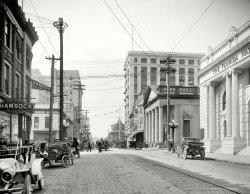
- Thompson Branch: 1920
- ... of sight just to the left, next to the George Washington Hotel which wrapped around the corner of the two streets. W. S. Thompson, who ... Posted by Dave - 08/29/2016 - 12:10pm -
![Thompson Branch: 1920 Washington, D.C., circa 1920. "People's Drug Store, 15th Street & New York Avenue N.W." National Photo Company glass negative. View full size.
Long time tenantW. S. Thompson has been there awhile.
There's a newspaper reference from the Evening Star, July 29, 1863:
"Important Local Mail Arrangements. The Postmaster General has selected the following places for station letter boxes for the convenience of our citizens. All letters dropped in these boxes, either for transmission by mail or local delivery, will be called for by the letter carriers for each district."
"Third District -- White, P., grocery,Thirteenth and P street: Kidwell A; Lawrence, druggest, between Thirteenth and Fourteenth streets; Thompson, W. S., druggist, New York avenue and Fifteenth street; Ford, Dr., druggist. Eleventh street and Pa. avenue; Dayton's bakery, ? 45ft Eleventh street, between G and H."
Also an ad from The National Republican, October 22, 1867:
Of Human BondageThe Bond Building is on the opposite corner of this city square at 14th & New York Ave. (SW corner). Liggett's is housed in the Home Life Building, which had its main entrance on G St.
Single Pane Vertical Jalousie?No clue what you would call those interesting 19th century windows that open vertically on a center pivot.
This arrangement would work very well for cleaning the glass.
But in hot and humid Washington DC summers, you could not have screens, to keep out insects, when you opened them. The building on the left does. Would you name that window style mosquito invitational?
[They're casement windows. - Dave]
Re: Single pane vertical jalousie?I've heard architects call these pivot windows. They can be horizontal or vertical. Casement windows open on hinges, like doors.
The kitchen at my elementary school had horizontal pivot windows, with half-cylindrical screens on the outside. A bit awkward to make, but you could adjust the windows to catch a breeze or keep rain out.
Not so many mosquitoes on the third floor, but I'd worry about pigeons.
Fire in 1899From the American Druggist and Pharmaceutical Record: Nov. 1899 “The pharmacy of W. S Thompson, at 703 Fifteenth Street, NW Washington, caught fire on the 1st and W. L. Hurxthal, the night prescription clerk had a narrow escape from death”
Drug store competitors.These buildings are along 15th Street Northwest in Washington just up and opposite the Treasury Building; New York Avenue is out of sight just to the left, next to the George Washington Hotel which wrapped around the corner of the two streets. W. S. Thompson, who built the building at center where People's is, was a major druggist in DC by the 1850s. Liggett's Drug Store at right is on the ground floor of the Bond Building. G Street is at far right. All of these buildings were razed to build The Washington Building.
Car IDHupmobile
(The Gallery, D.C., Natl Photo, PDS)](https://www.shorpy.com/files/images/SHORPY-29967u.thumbnail.jpg)
- Top Chefs: 1910
- ... Manufacturers of the impressively named "Imperial French Hotel Range" and other commercial-grade equipment. Below, an item from the ... Posted by Dave - 12/03/2014 - 7:27pm -
![Top Chefs: 1910 From circa 1910 somewhere in the Northeast comes this 5x7 inch glass negative labeled "Cooks in kitchen." An appetizing look back at whatever the opposite of vegetarian cuisine is. Gentlemen, start your skillets! View full size.
A HUGE wood-fired rangeNoting the absence of gas valves, I take it that that is a huge wood-fired range. What a challenge it is to bake anything without an automatic temperature control!
Can anyone process the image well enough to make out the name plate on the range, or the stenciled mfr. name on the equipment to the right, which I believe is a primitive gas-fired hot water heater for manual laundry or dish washing purposes.
Note the light streaming in from a light well in the ceiling. This is the diagonal line on the wall, and the reason that the bottom of door #2 appears lighter than the top. I think this is a basement location.
[More likely a coal-fired range. The bottom line says NEW YORK, and above that, something ending in WOOSTER ST. - Dave]
42 Wooster StreetAccording to this news item from the New York World in 1888, the range manufacturer is Dufarquet & Huot.
[Which seems to be a typo, the actual appellation being Duparquet & Huot. - Dave]
The Old MessThis resembles the kitchen in our mess hall when I was in the service. Except in this picture the stove is newer and cleaner.
SanityThe opposite of vegetarian cuisine is sane cuisine.
Mystery Door #2And the city health inspector asks, "what's behind door No. 2 ?? Do we really want to know?
[Possibly ... DANGER?? - Dave]
Duparquet, Huot & MoneuseManufacturers of the impressively named "Imperial French Hotel Range" and other commercial-grade equipment. Below, an item from the April 4, 1897 Washington Post.
(The Gallery, Found Photos, Kitchens etc.)](https://www.shorpy.com/files/images/SHORPY-155-02A.thumbnail.jpg)
- The Hamilton: 1908
- ... proprietor. 112 South Palmetto street. New and first-class hotel in all respects. Will open its first season December 1st, 1909. Rooms ... that big tree is the sapling we see in front of the old hotel.
View Larger Map
(The Gallery, Bicycles, DPC, ... Posted by Dave - 02/26/2014 - 2:31pm -
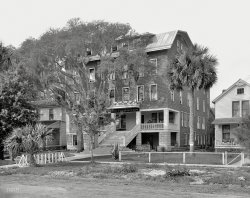
- Pittsburgh: 1956
- ... silver buildings to the left--without the Hilton Hotel that was built in front of them a few years later. The "PRE" and other ... Posted by Dave - 01/28/2013 - 11:58am -
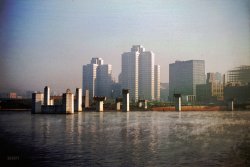
- The Wilson: 1908
- Circa 1908. "North Adams, Massachusetts -- Wilson Hotel." With "first-class moving pictures" at the Empire Theatre. 8x10 glass ... Posted by Dave - 04/22/2013 - 9:36am -
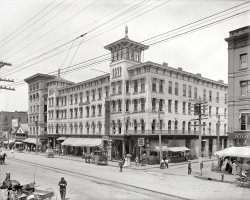
- Expansion Club: 1904
- ... Columbia Club 2.0 still stands and operates as a hotel, restaurant and meeting halls.
As a small child, I remember Mom ... Posted by Dave - 11/10/2016 - 11:05am -
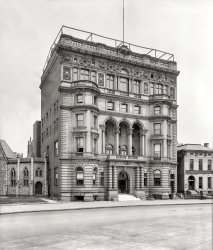
- Newark Luxe: 1944
- ...
Newark Ex-Luxe After becoming the Military Park Hotel and then going into a long period of decline, the building was demolished ... Posted by Dave - 09/15/2014 - 6:01am -
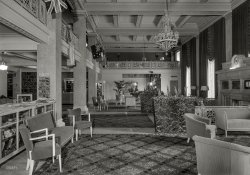
- Mail Pouch: 1910
- Circa 1910. "Columbus, Ohio, from Great Southern Hotel." Photobombed by the Mail Pouch Tobacco horse. 8x10 inch glass negative. ... Posted by Dave - 07/25/2015 - 2:40pm -
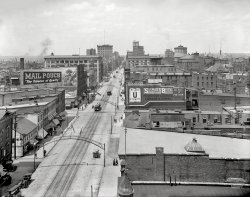
- Terminal Station: 1910
- ... is fantastic. What a great entrance to a cool boutique hotel that would have made.
(The Gallery, DPC, New Orleans, Railroads) ... Posted by Dave - 03/06/2019 - 11:18pm -
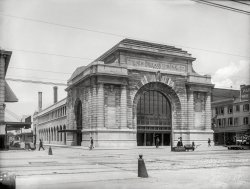
- Upward on Woodward: 1915
- ... with a fiberglass replica. It reopened with a boutique hotel, apartments, and a little bit of high end shopping.
Whitney ... Posted by Dave - 03/24/2022 - 4:18pm -
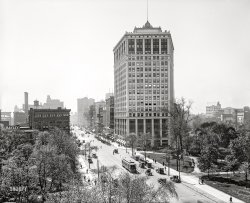
- Catskills Modern: 1953
- September 23, 1953. "Stevensville Hotel, Liberty, New York. View to dining room. Herbert Phillips, client." ... the Stevensville's main building as the Swan Lake Resort Hotel. It closed once more in 2003 after the gambling plans were shelved and ... Posted by Dave - 01/26/2014 - 2:35pm -
